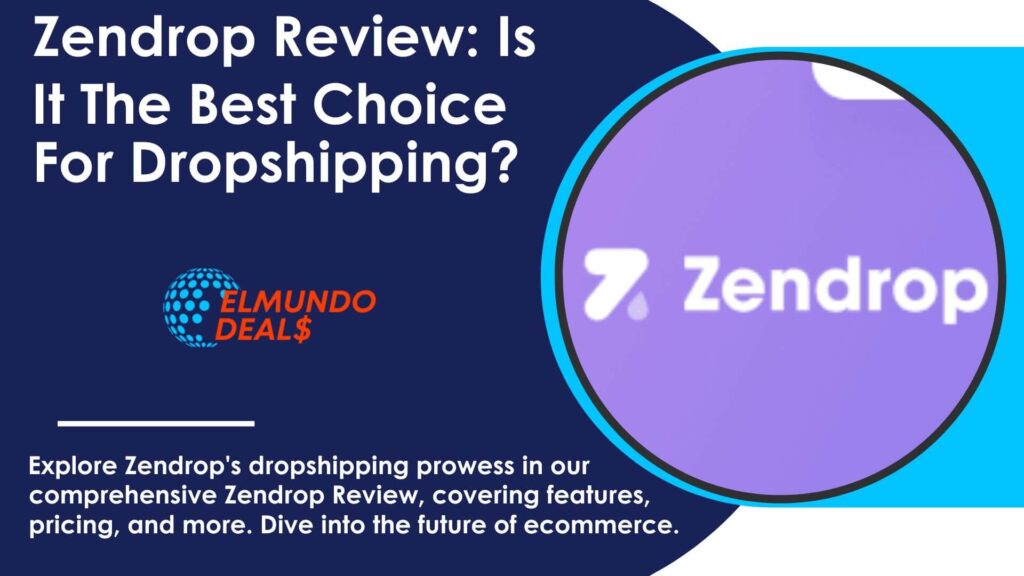How To Dropship On Amazon In 2024 – Amazon Dropshipping Business Ultimate Guide
Are you looking for a new way to make money online in 2024? Dropshipping on Amazon is becoming an effective and proven business model for generating additional income.
Not only does dropshipping allow you to create your store without needing physical space, but it also offers flexibility, convenience, low start-up costs and no inventory or shipping responsibility.
But how do you get started with dropshipping on Amazon? In this article, we’ll walk through the steps: How To Start Dropshipping On Amazon In 2023, a fantastic way to offer dropshipping.
Key Takeaways:
- Understanding Dropshipping: Clarify the concept of dropshipping as a retail fulfillment method where sellers partner with suppliers to ship products directly to customers without holding inventory.
- Amazon’s Requirements: Highlight the importance of meeting Amazon’s guidelines, such as having a professional seller account and sourcing products from legitimate suppliers, to ensure compliance and avoid account suspension.
- Customer Service and Returns: Emphasize the seller’s responsibility for providing high-quality customer service and handling returns effectively, including setting clear return policies and communicating them to customers.
- Staying Compliant: Stress the need for sellers to stay informed about Amazon’s policies, regularly monitor their account health, and maintain transparency with customers to build trust and prevent negative feedback.
What Is Dropshipping?
Dropshipping is a retail fulfillment method in which the seller (you) doesn’t have to keep any inventory. Instead, you work with a third-party supplier who will ship the products directly to your customers. This means that you don’t need to handle any physical products, warehouse space, or shipping logistics.
You list the supplier’s products on your Amazon store, and when a customer makes a purchase, the supplier ships the product directly to them, exemplifying how Amazon dropshipping works.
This business model is ideal for those needing more resources or wanting to manage inventory and shipping. It also eliminates the risk of purchasing large amounts of inventory upfront, as you only order products from your supplier when a customer makes a purchase. This enables you to test out different products and see what sells best without the financial risk.
Is Dropshipping On Amazon Allowed?
There are general requirements for selling products on Amazon. However, before you start dropshipping on Amazon, it’s important to understand the specific rules and regulations for this business model.
Amazon Dropshipping Guide
To ensure a successful dropshipping business on Amazon, following their guidelines and requirements is crucial. These include:
- Having a professional seller account is crucial when you run a dropshipping business on Amazon.In order to list products for sale on Amazon, you’ll need to have a professional seller account, which requires a monthly fee. This is a basic way to start listing on Amazon. It also enables you to use FBA (Fulfillment by Amazon) services.
- Using legitimate suppliers: All products listed in your store must come from legitimate suppliers and not be counterfeit or illegal in any way. If Amazon finds out you’re selling illegitimate products, they may suspend your account or even take legal action against you.
- Providing high-quality customer service: As the seller, it’s your responsibility to provide excellent customer service, even though you’re not handling the shipping or returns process. This includes responding promptly to any inquiries or concerns from customers.
- Following Amazon’s shipping and return policies: As a dropshipper, you must adhere to Amazon’s shipping and return policies. It includes providing accurate delivery estimates and ensuring that returns are adequately handled.
Identify Yourself As The Seller
To ensure clarity and compliance with Amazon’s guidelines, it’s essential to clearly identify yourself as the ” seller of record” on your Amazon store. This helps build trust with potential customers and ensures compliance with Amazon’s policies.
To do this, you can use a few different methods:
- Creating a unique brand: When setting up your store, consider creating a unique brand name that you can use to identify yourself as the seller. This will help differentiate your store from others and establish your own brand identity.
- Including contact information: Make sure to include accurate contact information, such as an email address or phone number, on your store. This way, customers will know who they buy from and how to reach you if needed.
- Using Inserts in Packages: Some sellers choose to include inserts in their packages that thank the customer for the purchase and mention their brand name or contact information. It can be a subtle way to reinforce your identity as the seller.
Responsible For Accepting And Processing Returns
As a dropshipper, you are responsible for accepting and processing customer returns. Customers dissatisfied with their purchase will return the product to your address rather than the supplier’s.
To handle returns effectively, it’s important to have clear policies in place and communicate them to your customers. This includes:
- Defining the return period: Decide on a specific time frame within which customers can make returns, such as 30 days from the date of purchase. Communicate this clearly to customers.
- Specifying condition of returned products: Let customers know that all returned products must be unused and in their original packaging. This helps ensure you can still resell the product, maintaining inventory flexibility typical of listing on Amazon.
- Deciding who pays for return shipping: You can choose to cover the cost of return shipping or have the customer pay for it. This should be clearly stated in your return policy and your Amazon store.
Stay In Compliance With Amazon‘s Terms Of Service
In order to continue dropshipping on Amazon successfully, it’s crucial to stay in compliance with their terms of service. This includes regularly checking for updates and changes to their policies, as well as monitoring your seller metrics.
Some key points to keep in mind include:
- Monitoring your account health: Amazon uses various metrics to evaluate sellers’ performance, including customer feedback and order defect rate. Monitor these metrics regularly and take steps to improve them if needed.
- Keeping up with policy changes: Amazon’s policies are subject to change, so it’s essential to keep up with any updates or changes that may impact your dropshipping business. It is vital for return and shipping policies.
- Maintaining transparency with customers when managing your ecommerce store or your Amazon store is crucial. Accurate Amazon product listing descriptions are also important. For a positive online business environment, maintaining open communication with your customers and promptly and professionally addressing any issues or concerns is essential for those who run a dropshipping business. This helps build trust and can prevent negative feedback or reviews.
How To Dropship On Amazon?
Figure Out What Products You Want To Sell
The first step in starting dropshipping on Amazon is to figure out what products you want to sell. This can be based on your personal interests, market trends, or the products with high demand and low competition on Amazon. It’s essential to research and analyze different Amazon product options before making a decision to secure the most profitable items for your dropshipping business.
Also, consider each product’s profit margin and scalability potential. Furthermore, it’s a good idea to start with fewer products and expand your inventory as you gain experience in profitable Amazon dropshipping.
Find Reliable Dropshipping Merchants
After deciding on the products you want to sell, the next step is finding reliable dropshipping merchants. These suppliers will fulfill orders on your behalf and ship directly to your customers.
You can find these merchants through online retailer directories, trade shows, or by reaching out to manufacturers directly. It’s important to thoroughly vet these merchants and ensure they have a good reputation and can provide high-quality products at competitive prices.
You should also establish clear communication and understand their shipping and processing customer returns policies to avoid any issues in the future. Remember, the reliability of your merchants will directly impact the success of order fulfillment and your dropship on Amazon.
Order Product Samples
Before listing products or adding an item to your eCommerce store or your Amazon store, ordering product samples from your dropshipping merchants is important. This ensures the quality of your listing on Amazon and allows you to inspect the quality of the products and ensure that they meet your standards before selling them to customers.
It’s also a good idea to test out the shipping process by ordering a sample. It can help identify any potential issues and give you a better understanding of the customer experience.
Remember that you may need to pay for these samples, but it’s a worthwhile investment to ensure the success and satisfaction of your customers. Overall, ordering product samples is an essential step in starting a dropshipping business on Amazon, ensuring that the quality meets your and your customers’ expectations—end of the document.
Set Up Your Amazon Store
Once you have your products and suppliers, it’s time to set up your Amazon store. This is crucial to creating an Amazon business platform for your dropshipping venture. It involves creating a seller account and listing your products on the marketplace. This initial step is fundamental to start selling through the dropshipping model on Amazon.
Optimize your product listings with high-quality images, detailed descriptions, and competitive prices. Research and use relevant keywords to improve visibility and attract potential customers for your dropshipping Amazon business.
Additionally, familiarize yourself with Amazon’s seller policies and guidelines to avoid any violations. Once your store is set up, it’s important to regularly monitor and manage your inventory, pricing, and customer reviews to be successful in selling through the dropshipping model on Amazon.
List Your Products
Write this in 120 words.
The final step is listing your products on Amazon. This involves creating product listings for each item you want to sell, including images, descriptions, and pricing.
Use high-quality images that accurately represent the product and provide detailed descriptions to inform potential customers about its features and benefits. Price your products competitively to attract buyers, but also consider your profit margin, keeping in mind that dropshipping fees vary by product.
Relevant keywords in your listings are essential to improving your visibility on Amazon. You can also utilize Amazon’s advertising options to promote your products further and increase sales.
Promote Your Store
Once your store is set up and your products are listed, it’s important to promote your business model and store to attract customers. You can do this through various marketing efforts, such as social media advertising, influencer collaborations, or email marketing to promote your products to dropship.
You can also utilize Amazon’s built-in promotional tools, such as Sponsored Products or Deals, to reach a larger audience. Remember to utilize customer reviews and ratings to build trust and credibility for your store.
Regularly monitoring and analyzing the performance of your promotional efforts can help you refine your strategies and attract more customers to your dropshipping business on Amazon. Keeping up with these marketing efforts is crucial for success in the competitive marketplace, primarily when you aim to increase visibility for your listing on Amazon.
Build Your Website
While having a successful dropshipping business on Amazon is vital, having your website is also beneficial. This gives you more control over your brand and the customer experience.
Your website can showcase your products, provide additional information or resources, and even offer special deals or promotions. It can drive traffic to your Amazon store and increase sales, optimizing your Amazon product listing.
Additionally, having a website allows you to diversify your income streams by selling products through other marketplaces or even creating your private label brand beyond just selling via Amazon, which is especially relevant for those utilizing the dropshipping method. It’s important to regularly maintain and update your website to keep it relevant and engaging for potential customers.
Keep in mind that building a website may require additional resources and investment, but the long-term benefits can make it a worthwhile choice for your dropshipping business on Amazon.
How To Start Dropshipping On Amazon: Tips For Success
Get Reviews From Customers
Customer reviews are crucial for the success of your dropshipping business on Amazon. Positive reviews can improve your visibility, credibility, and sales.
Make sure to provide high-quality products and excellent customer service to encourage positive reviews. You can also ask satisfied customers to leave a review or offer incentives such as discounts or free products in exchange for a review to enhance your dropshipping Amazon business’s reputation.
Responding to both positive and negative reviews shows that you value customer feedback and are dedicated to providing exceptional service. Regularly monitoring and addressing reviews can also help identify areas for improvement in your business.
Focus On Branding
While dropshipping on Amazon can be lucrative, focusing on branding is crucial to stand out from the competition. This involves creating a unique brand identity through your store name, logo, packaging, and customer experience.
Branding helps build customer trust and recognition and can lead to repeat purchases and word-of-mouth referrals. Ensure consistency in your branding across all platforms, including your website and social media.
You can also utilize Amazon’s brand registry program to protect your brand and gain access to additional tools for marketing and advertising. Prioritizing branding can help differentiate your products from other sellers on the marketplace and contribute to the success of your dropshipping business on Amazon, showcasing how applying the dropshipping method effectively can lead to profitability and brand recognition.
Niche Down
One way to stand out from the competition on Amazon is by niching down. Instead of trying to sell a wide range of products, focus on a specific niche or category.
This allows you to become an expert in that particular area and better understand your target audience’s needs and preferences. You can also tailor your marketing efforts towards a specific niche, making it easier to reach potential customers.
Niching down can also help you source and select high-quality products that cater to your niche audience’s interests, enhancing the appeal of each item on Amazon you offer. This can lead to higher customer satisfaction and drive more sales. Feel free to experiment with different niches and find the one that works best for your dropshipping business on Amazon. This exploration is key to starting a dropshipping business that thrives.
Pros and Cons of Dropshipping on Amazon
Before starting your dropshipping business on Amazon, here are some pros and cons to consider.
Pros:
As an e-commerce giant, Amazon provides various tools and resources for sellers, such as built-in promotional tools, customer reviews and ratings, access to their brand registry program, and the opportunity to create an Amazon product listing.
Cons:
Is Amazon Dropshipping Profitable?
Is engaging in Amazon dropshipping a profitable venture? Considering the dropshipping fee structure and competition, strategic planning is essential for successful Amazon dropshipping work. Understanding the pros and cons of Amazon dropshipping is crucial before delving into this business model.
Identifying suitable products for dropships like Amazon is critical to success. Learning how to dropship efficiently and understanding the nuances of the dropshipping business model is essential.
When considering the cons of Amazon dropshipping, factors such as low-profit margins, Amazon fees, and fierce competition among sellers on Amazon’s platform come into play. However, despite the cons, dropshipping on Amazon can be lucrative if approached strategically.
To make dropshipping work on Amazon, sellers need to navigate challenges such as winning the Amazon Buy Box, dealing with Amazon fees, and understanding the state of the Amazon seller market. They also need to set up an Amazon seller account, list products on Amazon, and use dropshipping tools.
One of the pros of Amazon dropshipping is the ability to list products on Amazon without keeping inventory, which can save money on Amazon fees. However, Amazon dropshipping margins tend to be low.
It’s vital to note that Amazon’s dropshipping policy should be adhered to, as violating it may lead to complications. Additionally, sellers considering dropshipping from Amazon should explore alternatives to dropshipping and evaluate if this method aligns with their business goals.
While Amazon dropshipping offers benefits, sellers should carefully weigh the pros and cons, set up their Amazon accounts meticulously, and embrace a strategic approach to make the venture profitable.
Amazon Dropshipping Tools and resources
Here are some helpful tools and resources to help you succeed in your Amazon dropshipping business on Amazon:
Jungle Scout:
Jungle Scout is a comprehensive product research tool that helps you find profitable products to sell on Amazon. It provides data analysis, sales estimates, keyword tracking, and competitor research to make informed product decisions.
FeedbackWhiz:
FeedbackWhiz is an all-in-one feedback management tool for Amazon sellers. It automates the process of requesting and managing reviews, sending personalized emails to customers, and tracking product reviews and ratings.
Helium 10:
Helium 10 is a suite of tools designed to help you optimize your Amazon listing and increase sales. It includes features such as keyword research, listing optimization, and inventory management.
SellerApp:
SellerApp is another all-in-one tool for Amazon sellers that offers product research, keyword tracking, and advertising solutions. It also provides insights into your competition’s sales data to help you make informed decisions.
Amazon Brand Registry:
The Amazon Brand Registry program helps protect your brand by allowing you to register your brand and products with Amazon. This provides additional marketing, advertising, and inventory management tools.
Amazon Seller University:
Amazon Seller University offers free online courses and tutorials on product listing optimization, advertising, and fulfillment options. It’s an excellent resource for new sellers looking to learn the ins and outs of selling on Amazon.
Conclusion: How To Dropship On Amazon
Dropshipping on Amazon can be a lucrative and low-risk business opportunity, offering significant benefits of dropshipping, but it’s essential to understand the pros and cons before getting started.
Leveraging tools and resources like Jungle Scout, FeedbackWhiz, and Amazon Brand Registry can increase your chances of success in this competitive marketplace.
Remember to carefully research and follow Amazon’s policies when choosing products to sell, managing inventory, and handling customer service inquiries. With the right strategy and approach, using Amazon for dropshipping can be a profitable venture for your e-commerce business.
So, if you’re interested in starting your own dropshipping ecommerce business, research and utilize the various tools and resources available to help you succeed on Amazon’s platform.
FAQs On Amazon Dropshipping Business
Does Amazon allow dropshipping?
Yes, Amazon allows dropshipping as long as you comply with their policies and guidelines, making it clear that dropshipping can be a great business model to adopt. This includes ensuring that the dropshipping products are available for immediate shipment and that you are responsible for handling customer service inquiries.
Do I need to have an inventory to start dropshipping on Amazon?
No, one of the advantages of dropshipping is that you don’t need to hold inventory. However, it’s essential to have a reliable dropshipping supplier who can fulfill orders and drop shipping them in a timely manner.
Can I use my logo and branding on products sold through dropshipping on Amazon?
Yes, you can use your brand’s logo and external packaging for products sold through dropshipping on Amazon. It can help differentiate your products from others and create a more cohesive brand image.
What are Amazon’s fees for dropshipping?
Depending on the product category and shipping method, Amazon charges various fees, such as referral and fulfillment fees. It’s important to calculate these costs carefully when pricing your products.
Can I sell any product through dropshipping on Amazon?
No, there are certain restrictions on what products you can sell through dropshipping on Amazon. These include restricted categories, prohibited products, and Amazon’s counterfeit and copyright infringement policies, all crucial considerations when creating an Amazon product listing. Researching and complying with these guidelines before choosing a product to sell is important.













